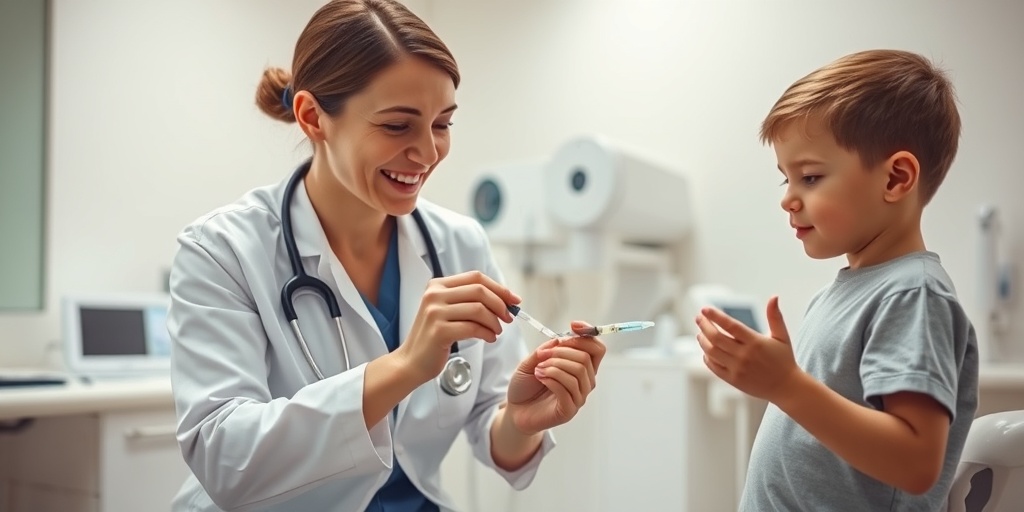What Is GHD?
GHD, or Growth Hormone Deficiency, is a medical condition characterized by insufficient production of growth hormone (GH) by the pituitary gland. This hormone plays a crucial role in growth, metabolism, and overall health. GHD can occur in both children and adults, leading to a variety of physical and psychological symptoms.
Understanding Growth Hormone
Growth hormone is essential for several bodily functions, including:
- Growth and Development: In children, GH is vital for normal growth and development of bones and tissues.
- Metabolism: It helps regulate body composition, muscle and bone mass, and fat distribution.
- Cell Repair: GH aids in the repair and regeneration of cells, contributing to overall health.
When the pituitary gland does not produce enough GH, it can lead to GHD, which can manifest in various ways depending on the age of onset.
Causes of GHD
GHD can be caused by several factors, including:
- Genetic Mutations: Some individuals may inherit conditions that affect the pituitary gland’s ability to produce growth hormone.
- Brain Injuries: Trauma or tumors affecting the pituitary gland can lead to GHD.
- Chronic Diseases: Certain chronic illnesses can impact hormone production.
GHD Symptoms
The symptoms of GHD can vary significantly between children and adults, and they can affect physical health, emotional well-being, and quality of life.
Symptoms in Children
In children, GHD can lead to:
- Short Stature: Children with GHD may be significantly shorter than their peers.
- Delayed Puberty: The onset of puberty may be delayed due to insufficient growth hormone levels.
- Increased Body Fat: Children may have a higher percentage of body fat, particularly around the abdomen.
- Low Energy Levels: They may exhibit fatigue and decreased physical activity.
Symptoms in Adults
In adults, GHD can manifest as:
- Decreased Muscle Mass: Adults may experience a reduction in muscle strength and mass.
- Increased Body Fat: Particularly around the waist, leading to an increased risk of obesity.
- Fatigue and Weakness: A general sense of tiredness and lack of energy can be prevalent.
- Emotional Changes: Adults may experience mood swings, anxiety, and depression.
Diagnosis and Treatment
If you suspect that you or your child may have GHD, it is essential to consult a healthcare professional. Diagnosis typically involves:
- Medical History: A thorough review of symptoms and family history.
- Blood Tests: To measure growth hormone levels and assess overall health.
- Imaging Tests: MRI scans may be used to examine the pituitary gland.
Treatment for GHD often includes growth hormone therapy, which involves regular injections of synthetic growth hormone. This therapy can help improve growth in children and restore metabolic functions in adults.
For more information on GHD and related health topics, consider visiting Yesil Health AI, a valuable resource for evidence-based health answers.
Understanding GHD is crucial for early diagnosis and effective treatment. If you notice any symptoms in yourself or your child, don’t hesitate to seek medical advice. Early intervention can make a significant difference in managing this condition! 🌟

GHD Causes
Growth Hormone Deficiency (GHD) is a condition that affects individuals of all ages, leading to a variety of health issues due to insufficient production of growth hormone by the pituitary gland. Understanding the causes of GHD is crucial for effective diagnosis and treatment. Here are some of the primary causes:
Genetic Factors
One of the most significant causes of GHD is genetic predisposition. Certain genetic mutations can affect the development and function of the pituitary gland, leading to a reduced ability to produce growth hormone. Conditions such as Prader-Willi syndrome and Turner syndrome are examples of genetic disorders that can result in GHD.
Congenital Conditions
Some individuals are born with congenital conditions that affect the pituitary gland’s ability to produce growth hormone. These conditions can arise from developmental issues during pregnancy, resulting in structural abnormalities of the pituitary gland.
Brain Injuries
Trauma to the head can also lead to GHD. Injuries that damage the pituitary gland or the hypothalamus (the part of the brain that regulates hormone production) can disrupt the normal secretion of growth hormone. This can occur due to accidents, falls, or surgical procedures.
Infections and Tumors
Certain infections, such as meningitis, can affect the brain and pituitary gland, leading to GHD. Additionally, tumors in or near the pituitary gland can interfere with hormone production. These tumors can be benign or malignant and may require medical intervention.
Radiation Therapy
Individuals who have undergone radiation therapy for brain tumors or other conditions may experience damage to the pituitary gland, resulting in GHD. The effects of radiation can lead to a decrease in hormone production over time.
GHD Risk Factors
Identifying the risk factors associated with Growth Hormone Deficiency (GHD) can help in early detection and management of the condition. Here are some key risk factors to consider:
Age
While GHD can occur at any age, it is more commonly diagnosed in children and adolescents. However, adults can also develop GHD, particularly if they have a history of pituitary disorders or brain injuries.
Family History
A family history of hormonal disorders can increase the likelihood of developing GHD. If there are known cases of GHD or related conditions in your family, it may be beneficial to discuss this with a healthcare provider.
Previous Medical Conditions
Individuals with a history of certain medical conditions, such as hypopituitarism or other endocrine disorders, are at a higher risk of developing GHD. Additionally, those who have experienced significant head trauma or brain surgery should be monitored for potential hormone deficiencies.
Chronic Illnesses
Chronic illnesses, particularly those affecting the endocrine system, can contribute to the development of GHD. Conditions such as diabetes or hypothyroidism can impact hormone levels and overall health.
Environmental Factors
Exposure to certain environmental factors, such as toxins or radiation, may also play a role in the development of GHD. While more research is needed in this area, it is essential to consider these factors, especially for individuals living in areas with high levels of environmental pollutants.
Understanding the causes and risk factors associated with GHD is vital for early diagnosis and effective treatment. If you or someone you know is experiencing symptoms related to growth hormone deficiency, it is important to consult a healthcare professional for a thorough evaluation and appropriate management. 🌟

GHD Diagnosis
Growth Hormone Deficiency (GHD) is a condition that can significantly impact an individual’s growth and overall health. Diagnosing GHD involves a comprehensive approach that includes clinical evaluations, medical history, and specific tests. Understanding the diagnostic process is crucial for timely intervention and effective management.
Clinical Evaluation
The first step in diagnosing GHD is a thorough clinical evaluation. Healthcare providers will assess the patient’s growth patterns, physical development, and any symptoms that may indicate a deficiency in growth hormone. Common signs of GHD include:
- Short stature compared to peers
- Delayed puberty or sexual development
- Increased body fat, particularly around the abdomen
- Low energy levels and fatigue
In children, a growth chart is often used to track growth over time, helping to identify any deviations from expected growth patterns. For adults, symptoms may be less obvious but can include decreased muscle mass, increased body fat, and reduced quality of life.
Medical History
A detailed medical history is essential in the diagnosis of GHD. This includes:
- Family history of growth disorders
- Any previous medical conditions or treatments that may affect growth hormone levels
- Birth history, including any complications during pregnancy or delivery
Understanding these factors can help healthcare providers determine the likelihood of GHD and guide further testing.
Diagnostic Tests
Once a clinical evaluation and medical history are completed, specific tests are conducted to confirm GHD. These may include:
- Growth Hormone Stimulation Tests: These tests measure the body’s ability to produce growth hormone in response to stimuli. Common stimulants include arginine and insulin.
- Insulin-like Growth Factor 1 (IGF-1) Test: This blood test measures the level of IGF-1, a hormone that reflects growth hormone activity in the body.
- MRI Scans: In some cases, imaging studies may be performed to check for abnormalities in the pituitary gland, which produces growth hormone.
These tests help confirm the diagnosis and rule out other conditions that may mimic GHD symptoms.
GHD Treatment Options
Once diagnosed, GHD can be effectively managed with appropriate treatment options. The primary goal of treatment is to restore normal growth hormone levels and improve the patient’s quality of life. Here are the main treatment options available:
Growth Hormone Replacement Therapy
The most common and effective treatment for GHD is Growth Hormone Replacement Therapy (GHRT). This therapy involves the administration of synthetic growth hormone, which can help:
- Promote growth in children
- Increase muscle mass and strength in adults
- Reduce body fat
- Enhance overall well-being and energy levels
GHRT is typically administered through daily injections, and the dosage is tailored to the individual’s needs. Regular monitoring is essential to adjust the treatment as necessary.
Monitoring and Follow-Up
Regular follow-up appointments are crucial for individuals undergoing GHRT. Healthcare providers will monitor growth patterns in children and assess changes in body composition and overall health in adults. Adjustments to the treatment plan may be made based on these evaluations.
Addressing Underlying Conditions
In some cases, GHD may be secondary to other medical conditions, such as tumors or genetic disorders. Addressing these underlying issues is vital for effective treatment. This may involve:
- Surgery to remove tumors affecting the pituitary gland
- Medication to manage associated conditions
By treating the root cause, healthcare providers can improve the effectiveness of GHD management.
Lifestyle Modifications
In addition to medical treatments, certain lifestyle modifications can support overall health and well-being for individuals with GHD. These may include:
- Regular exercise: Engaging in physical activity can help improve muscle mass and overall fitness.
- Balanced diet: A nutritious diet rich in vitamins and minerals supports growth and development.
- Stress management: Techniques such as meditation and yoga can enhance mental well-being.
Incorporating these changes can complement medical treatments and promote a healthier lifestyle.

GHD Management Strategies
Managing GHD (Growth Hormone Deficiency) effectively requires a comprehensive approach that encompasses medical treatment, lifestyle adjustments, and ongoing monitoring. Here are some key strategies to consider:
1. Medical Treatment
The cornerstone of GHD management is hormone replacement therapy. This involves the administration of synthetic growth hormone to compensate for the deficiency. Here are some important aspects:
- Personalized Dosage: Treatment should be tailored to the individual, taking into account age, weight, and specific health needs.
- Regular Monitoring: Frequent check-ups with an endocrinologist are essential to adjust dosages and monitor progress.
- Potential Side Effects: Be aware of possible side effects, such as joint pain or swelling, and discuss these with your healthcare provider.
2. Nutritional Support
A balanced diet plays a crucial role in managing GHD. Here are some dietary tips:
- Protein-Rich Foods: Incorporate lean meats, fish, eggs, and legumes to support muscle growth and repair.
- Healthy Fats: Include sources of omega-3 fatty acids, such as fish and nuts, to promote overall health.
- Complex Carbohydrates: Whole grains, fruits, and vegetables provide essential nutrients and energy.
3. Physical Activity
Regular exercise is vital for individuals with GHD. It helps improve muscle mass, strength, and overall well-being. Consider the following:
- Strength Training: Incorporate resistance exercises to build muscle and improve metabolism.
- Aerobic Activities: Engage in activities like walking, swimming, or cycling to enhance cardiovascular health.
- Flexibility and Balance: Include yoga or stretching exercises to improve flexibility and prevent injuries.
4. Psychological Support
Living with GHD can be challenging, both physically and emotionally. Seeking psychological support can be beneficial:
- Counseling: Consider therapy to address any emotional challenges related to GHD.
- Support Groups: Connecting with others who have GHD can provide valuable insights and encouragement.
GHD Outlook and Prognosis
The outlook for individuals diagnosed with GHD can vary significantly based on several factors, including the age of diagnosis, the underlying cause of the deficiency, and the effectiveness of treatment. Here’s what you need to know:
1. Early Diagnosis and Treatment
Early diagnosis and prompt treatment are crucial for a positive prognosis. Children diagnosed with GHD often experience:
- Improved Growth: With appropriate hormone therapy, many children can achieve normal height and growth patterns.
- Enhanced Quality of Life: Treatment can lead to improved energy levels, mood, and overall well-being.
2. Long-Term Management
For adults with GHD, long-term management is essential. The prognosis can include:
- Increased Muscle Mass: Hormone replacement therapy can help regain muscle mass and strength.
- Better Metabolic Health: Proper management can lead to improved metabolism and reduced risk of obesity.
3. Monitoring and Adjustments
Regular follow-ups with healthcare providers are vital to monitor hormone levels and adjust treatment as necessary. This ongoing care can help:
- Prevent Complications: Monitoring can help identify and address potential complications early.
- Enhance Treatment Efficacy: Adjusting dosages based on individual response can optimize treatment outcomes.
4. Lifestyle Factors
Incorporating healthy lifestyle choices can significantly impact the prognosis for individuals with GHD:
- Regular Exercise: Staying active can improve physical health and emotional well-being.
- Balanced Diet: A nutritious diet supports overall health and complements hormone therapy.
In conclusion, while GHD presents challenges, effective management strategies and a positive outlook can lead to improved health and quality of life. By focusing on medical treatment, nutrition, exercise, and psychological support, individuals with GHD can thrive and achieve their health goals. 🌟

Frequently Asked Questions about GHD
What is GHD?
GHD stands for “Good Hair Day,” and it is a brand known for its high-quality hair styling tools, including hair straighteners, curlers, and hair dryers. Their products are designed to help you achieve salon-quality results at home.
What makes GHD hair straighteners unique?
GHD hair straighteners are renowned for their advanced technology, which includes heat styling that protects your hair while delivering exceptional results. They feature ceramic plates that glide smoothly through your hair, reducing frizz and enhancing shine.
How do I choose the right GHD product for my hair type?
When selecting a GHD product, consider your hair type and styling needs. For fine hair, a lighter model may be suitable, while thicker hair may benefit from a more powerful straightener or curler. Additionally, GHD offers various tools like the GHD Platinum Plus for versatile styling options.
Can I use GHD tools on wet hair?
Some GHD products, like the GHD Duet Blowdry, are specifically designed for use on wet hair. However, most straighteners and curlers should be used on dry hair to prevent damage and achieve the best results.
How do I maintain my GHD tools?
- Regularly clean the plates with a damp cloth to remove product buildup.
- Store your tools in a safe place to avoid damage.
- Follow the manufacturer’s instructions for care and maintenance.
Are GHD products suitable for all hair types?
Yes, GHD products are designed to cater to a variety of hair types. Whether you have straight, wavy, or curly hair, there is a GHD tool that can help you achieve your desired look.
Where can I purchase GHD products?
You can find GHD products at authorized retailers, beauty supply stores, and online platforms. Always ensure you are buying from a reputable source to guarantee authenticity.
What is the warranty on GHD products?
GHD typically offers a warranty on their products, which can vary by model. It’s advisable to check the warranty details at the time of purchase for specific information.
Can I use GHD tools while traveling?
Many GHD products are travel-friendly, featuring dual voltage capabilities. However, it’s essential to check the specifications of your specific model to ensure compatibility with international voltage standards.
How long does it take for GHD tools to heat up?
Most GHD straighteners and curlers heat up in just a few seconds, allowing for quick and efficient styling. This feature is particularly beneficial for those with busy schedules.
Are GHD tools worth the investment?
Many users find that the quality and performance of GHD tools justify the investment. Their durability, effectiveness, and advanced technology often lead to long-term satisfaction and results.




